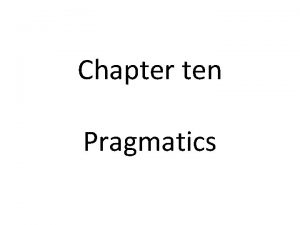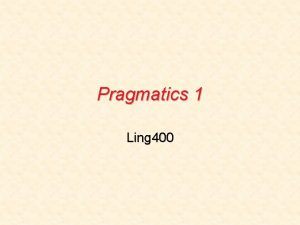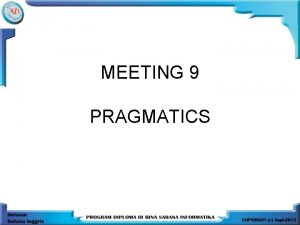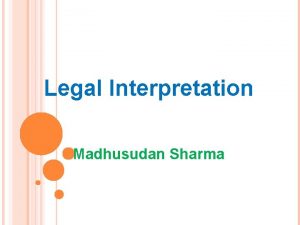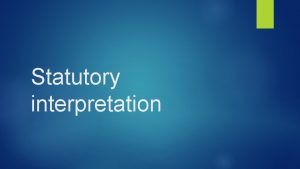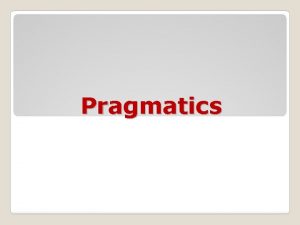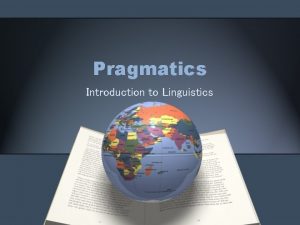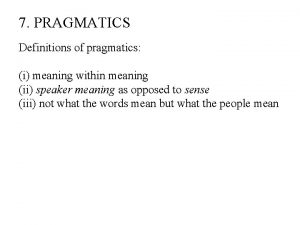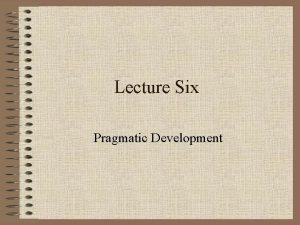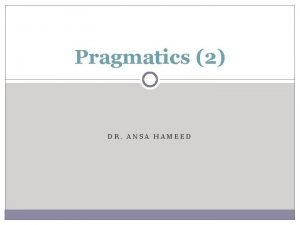Pragmatics Pragmatics is concerned with the interpretation of












- Slides: 12

Pragmatics

• #Pragmatics is concerned with the interpretation of linguistic meaning in context. • #The study of what speakers mean or ‘speaker’s meaning’, is called pragmatics. • According to Yole, ‘Pragmatics is the study of invisible meaning or how we recognize what is meant even when it is not actually said or written. That’s why; the speaker must be able to depend on a lot of shared assumptions and expectations when they try to communicate.

• Our interpretation of the meaning of the sign is not based solely on the words, but on what we think the writer intend to communicate. • Co-context: Linguistic context is known as cocontext. The surrounding of the co-context has a strong effect on what we think the word probably means.

• Deixis: There are some very common words in our language that can’t be interpreted at all if we don’t know the context, especially the physical context of the speaker. For exp: here, this , that; now and then, yesterday, today and tomorrow • To point things-Person deixis • To point location-spatial deixis • To point time-temporal deixis

• Reference: It is an act by which a speaker (writer) uses language to enable a listener to identify something. • # For each word or phrase there is a ‘range of reference’ • Linguistic context: Discourse • Linguistic knowledge accounts for speakers’ ability to combine phonemes into morphemes, morphemes into words, words into sentences. Knowing a language also permits combining sentences to express complex thoughts and ideas. These larger linguistic units are called discourse.

• Discourse analysis • how speaker combine sentences into broader speech units • concerns with style appropriateness, cohesiveness, topic/subtopic structure, difference between written and spoken discourse as well as grammatical properties

• Situational context: • According to Rodman, ‘Much of the contextual knowledge is knowledge of who is speaking, who is listening, what objects are being, discussed and general facts about the world we live in, called situational context’. • • Maxims of conversation • Grice calls the conversational principle –cooperative principle • #Make your conversational contribution as such is required, at the stage at which it occurs, by the accepted purpose or direction of the talk exchanged in which you are engaged.

• # Emphasis on assumption • #These arise from basic rational considerations and may be formulated as guidelines for the efficient and effective use of language in conversation to further cooperative ends. • Four basic Maxims of conversation : • Maxim of Quantity: • Make your contribution as informative as is required for the current purpose of the exchange

• Maxim of Quality: Try to make your contribution on that is true, • a ) don’t say what you believe to be false • b ) don’t say that for which you lack adequate evidence. • Maxim of Relevance: Make your contribution relevant (to time , place, topic)

• • • Maxim of Manner: #avoid obscurity # avoid ambiguity # be brief # be orderly

• Floutings or Exploitations: • Grice considers the second kind of implicature labeled ‘flouting’ or exploitations. • Flouting refers to implicatures that come about by overtly and blatantly not following some maxim in order to exploit it for communication purpose. • Floutings of quality: Hyperbole, metaphor, irony, satire are used to violate truth of quality.

• Floutings of quantity: • It is violated in creating prolixity if we say too much and terseness if we are too brief. • • Floutings of relevance are performed so as to signal some sort of embarrassments or a desire to change the subject. • Floutings of manner: The maxim of manner is violated either for humour or in order to establish solidarity between speakers and exclude an over hearer from the conversation.
 How does interpretation b differ from interpretation a
How does interpretation b differ from interpretation a Vẽ hình chiếu vuông góc của vật thể sau
Vẽ hình chiếu vuông góc của vật thể sau Thế nào là mạng điện lắp đặt kiểu nổi
Thế nào là mạng điện lắp đặt kiểu nổi Cách giải mật thư tọa độ
Cách giải mật thư tọa độ Lời thề hippocrates
Lời thề hippocrates Tư thế worms-breton
Tư thế worms-breton Vẽ hình chiếu đứng bằng cạnh của vật thể
Vẽ hình chiếu đứng bằng cạnh của vật thể Quá trình desamine hóa có thể tạo ra
Quá trình desamine hóa có thể tạo ra Khi nào hổ mẹ dạy hổ con săn mồi
Khi nào hổ mẹ dạy hổ con săn mồi điện thế nghỉ
điện thế nghỉ Các châu lục và đại dương trên thế giới
Các châu lục và đại dương trên thế giới Các loại đột biến cấu trúc nhiễm sắc thể
Các loại đột biến cấu trúc nhiễm sắc thể












